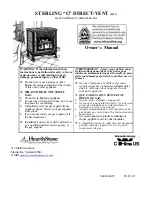
26
1. The heater has to work, switched to maximum power on the control box
2. Loose the screw 2 by two turns
3. Insert the manometer hose (inside diameter of 9 mm) onto conical throat
4. Measure the jet pressure at maximum power
5. With two-stage heater disconnect the dual cable C - this switches the heater to minimum power
6. With two-stage heater measure the jet pressure at minimum power
7. With two-stage heater connect back the dual cable C
8. Remove the manometer hose from conical throat, tighten the screw 2 and perform the gas leakage
test with foaming solution or gas detector
With one-stage heaters, only the pressure on the jet at nominal power is adjusted. After setting the
pressures on the jet and oxygen content according to the above procedure, other values shall be within limits
according to the respective table of setting values. If differences are observed, check and repair the pipe
connections and connection of burner box and exhaust box.
1. Start the jet pressure measuring according to the description above
2. Jet pressure at maximum power can be adjusted by turning the brass setting screw 3 with hexagonal
head using 10 mm wrench - see fig. 43
3. Jet pressure at minimum power can be adjusted by turning the black screw 4 using cross-point
screwdriver while the brass screw 3 has to be held by 10 mm wrench in order to prevent its
movement. For the direction of screw turning in order to rise or decrease jet pressure, see fig. 43.
4. Switch the heater to minimum power by removing the dual cable (marked with the letter C in figure
43) and check the jet pressure, if necessary, for minimum power according to the table for the type
of radiator and the procedure above.
5. Switch the heater to rated power by connecting a dual cable and recheck the jet pressure at rated
power as described above. The direction of rotation of the screws to increase and decrease the
pressure on the nozzle, see Fig. 43.
6. After adjusting the pressures on the jet, let the heater work at nominal power for further 15-30
minutes to heat it up to working temperature. Then adjust the O2 content in flue gases to values
according to tables 16.1 for Helios 10 or according to Table 16.2, 16.3, 16.4 for Helios 20, or Table
16.5 , 16.6, 16.7 for Helios 30, or according to Tables 16.8, 16.9, 16.10 for Helios 40, and Helios 50.
Natural gas
Propane G31
Natural gas
Propane G31
Natural gas
Propane G31
3,0
1,9
3,0
1,9
3,0
1,9
G20: 10,0
27,0
G20: 10,0
27,0
G20: 10,0
27,0
G25: 13,0
G25: 13,0
G25: 13,0
G20: 12,5
12,0
G20: 12,5
12,5
G20: 12,5
12,5
G25: 11,6
G25: 11,6
G25: 11,6
150 - 160
150 - 160
100 - 105
100 - 110
50 - 57
55 - 60
9,5 - 10,0
10,0 - 10,5
9,5 - 10,0
10,0 - 10,5
9,8 - 10,5
10,0 - 10,5
0 - 20
0 - 20
0 - 20
0 - 20
0 - 20
0 - 20
100 - 150
130 - 180
100 - 150
130 - 180
100 - 150
130 - 180
6,5 - 6,0
6,5 - 7,0
6,5 - 6,0
6,5 - 7,0
6,5 - 6,0
6,5 - 7,0
90 - 90,5
90 - 90,5
94,5 - 95,5
94,0 - 95,0
99,5 - 102
97,0 - 99,0
Содержание HELIOS
Страница 1: ......















































